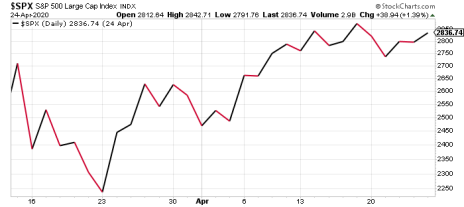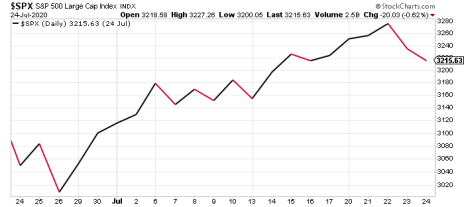Stocks fell sharply on Monday, the first trading day after the number of new COVID-19 cases in the U.S. topped 80,000 people for the first time. Coincidence? Not if you read the financial headlines, all of which blamed the rising case numbers for the day’s big fall. They may be right. If so, does that mean that this long-feared third wave of coronavirus spread could send stock prices plummeting back to late-March levels?
Data from the first two waves suggest not.
Stock Price Action During the First Wave
The first wave of COVID-19 in the U.S. lasted from about March 13, the day just about every state shut down as the daily number of cases topped 500 for the first time, until April 24, when daily cases peaked at more than 36,000. During those six weeks, here’s what the S&P 500 did.
It rose 4.6%. Granted, that was after the initial crash and there were some major bumps along the way—most notably in the 10 days that followed that March 13 spike in COVID cases to the March 23 stock market bottom. But as daily new cases rose from 599 on March 13 to more than 36,000 on April 24, stock prices went up.
Stock Price Action During the Second Wave
Now let’s look at the second wave of new coronavirus cases, measuring from the day new infections hit new highs on June 24 to their top above 79,000 daily cases exactly a month later, on July 24.
Stocks rose again, following a similar pattern. Shares initially sank, as investors processed the shock of cases rising again. Then, a few days later, stock prices rose again. This time, the run-up was even more pronounced than the first, as the S&P gained 5.4% in a month when the worst of the second wave took place.
[text_ad use_post='129622']
Now a third wave is upon us. Last Friday, daily COVID cases hit new highs above 81,000; they’ve now been above 50,000 every day for the last two weeks. And so far, stocks are down, with the S&P tumbling more than 4% since October 12. If prices follow a similar pattern to the first two waves, they will start to bounce back in the next few days and resume their long-term uptrend.
There’s just one major different this time: a pretty important presidential election is a week from today, as you may have heard. Until it’s over—or, I should say, until a clear winner is declared—stock prices aren’t likely to shoot up the way they did in late March or late June. The bounce-back might be delayed a week (or longer) this time around.
Other factors may mitigate another quick rebound rally from happening this time. For one, stock prices were higher when this recent bit of sluggishness began—the S&P was just shy of the all-time high (set in early September) when shares began to slide. In March, of course, they were coming off a historic market crash, down more than 30% in the blink of an eye. A rapid recovery was no surprise.
And in June, stock prices were still 11% below their pre-COVID, late-February highs. With the economy starting to heal, Wall Street quickly shook off the second-wave cobwebs and looked toward a brighter future.
What will happen to stocks now, at higher prices, with an uncertain election a week away, and with COVID cases accelerating to even scarier levels? That’s the trillion-dollar question. Like most of my colleagues here at Cabot, I’m not one for stock market predictions. But if I had to guess, the rebound will take a bit longer this time. However, barring anything entirely unforeseen or perhaps another lengthy nationwide lockdown (quite possible), stocks are likely to follow a similar pattern to what they did after the first two COVID waves: a sharp pullback, followed by an extended rebound.
With vaccines in the works and more economic repairs in the offing once it arrives, stock prices will likely be higher a year from now than they are today—perhaps much higher.
The question is, where will they be a quarter from now or even a month from now? That picture is far more muddled.
Invest accordingly.
[author_ad]



